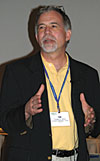
MCAA tested the waters with its members by holding a 90-minute "Green Building Forum: Challenges, Opportunities, and Requirements to Work Green" discussion, moderated by Tim Wentz, an instructor at the University of Nebraska-Lincoln.
The session was designed to provide input on the growing green building movement and how plumbing, mechanical, and service contractors could profit from it. Instead, the forum revealed, among many issues, the association needs to provide members more guidance in this newest trend in the construction industry.
"I think the concept of green buildings is a good one," admitted Wentz, after all session attendees had left the conference room. "But, I know we have to spread the word and make people understand what it is all about. We were trying to gauge here where MCAA can best help members in this market. I would say right now there is confusion as to what green building is."
AND THE DEFINITION IS ...?
Just getting a solid definition of green and sustainability from the crowd was not necessarily easy. One attendee thought these terms were initiated by the architectural world, designed to separate itself in the marketplace. Another used the words "saving energy" and "saving the environment." Yet another defined it "a social issue."When Wentz asked how attendees saw themselves in this arena, a few discussed some of the green projects they were doing or were involved with. One contractor, who made it known he was from California, indicated the entire process, in his opinion, is politically driven - period.
"The decision to go green on these projects appears to have been politically motivated, so they can say they have green," he said. "I haven't seen any life-cycle cost analysis to show where these advantages would be."
When asked if he thought building green equaled to more cost, the Californian agreed - as did those who chimed in. One attendee mentioned that even if it was 1.8 percent to 2.5 percent higher in cost, he thought it was too much to sell to an owner.
"I don't believe we're there yet," said one member. "If it is an individual, it's a hard sell, but if it is a public project, they don't mind."
Another contractor commented that saving energy is the bottom line for green projects. While all projects may not merit a ranking in LEED (Leadership in Energy and Environmental Design) Green Building rating system, he thought green meant, at the very least, saving energy.
"We've been providing energy savings for some time now," said the contractor. "Green is just another way to package these into projects."
DIFFERENT PERSPECTIVES
On the other side of the coin, some termed green as "an idea whose time has come.""What are we leaving for our children?" asked one woman in the crowd. "It's not just about payback and costs. That should not be the deciding factors."
A contractor from Australia said providing sustainable building practices is growing momentum in his country.
"It is getting stronger," he said, before identifying some of the green projects he has been involved with. "There is major growth in this [green] area."
One contractor said North America is behind the times and it should follow the ways paved by Europe.
"Europeans think we are nuts with our SUVs and our carefree attitude," he said. "We have to take a look at what Europe is doing. We can no longer avoid our environment."
Yet another noted that he thought Europe was ahead of the United States in terms of green simply because it had more of a backing from respective European governments.
"If we can't make it [green] real to them [owners]," charged another, "it won't happen here. We haven't made the conservation level we need to be."
MORE NEEDED
It was noted that LEED consulting firms are popping up across the country, each designed to help contractors, architects, and all construction fields follow LEED standards. LEED is a voluntary, consensus-based national standard for developing high-performance, sustainable buildings. USGBC's members, representing every sector of the building industry, developed and continue to refine LEED. These standards were created to, among other reasons, establish a common standard of measurement, promote integrated whole-building design practices, and stimulate green competition."I think we need some more guidance in this area," suggested one forum attendee. "I think more of us might want to do this, but it would be good if MCAA would look through all the material and then provide members some type of guidance. Maybe we need this to be government-driven."
Wentz assured members he would report the bottom-line conclusions to MCAA's board.
Publication date: 04/17/2006

Report Abusive Comment